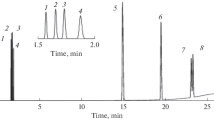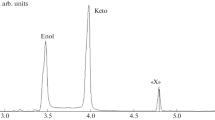Abstract
A high performance liquid chromatographic (HPLC) method has been developed for the quantitative determination of ethylene oxide (EO) oligomer distributions (% wt) in acetylated alcohol ethoxylates, R(OCH2CH2)nOH, from n=0, 1 to n=30 using a rotating disc-flame ionization detector. Both single carbon number and mixed carbon number alcohol-based (NEODOL® ethoxylates) samples have been analyzed by gradient elution with 2 different solvent systems on a Waters μ-Porasil column. With both solvent systems, 95% hexane is the initial solvent but with one system, 100% acetone is the final solvent and with the other, 10% methanol/90% acetone is used. The latter solvent elutes the higher ethoxylates from n=21 to n=30 quantitatively from the μ-Porasil column which the 100% acetone solvent fails to do. The 100% acetone solvent separates n=2 and n=3 from n=0,1 which the methanol-containing solvent does not do. Response factors for n=3 and n=8 have been experimentally determined and the response factors for the other EO units have been calculated from these 2 results. The corrected EO oligomer distributions for both NEODOL® 25-9 and NEODOL® 23-6.5 determined by HPLC are in good agreement with those determined earlier by circular thin layer chromatography (up to n=16 can be determined by this method). The average EO numbers determined by the HPLC method and by a wet chemical (phthalic anhydride) method are in excellent agreement for the above 2 samples and a sample of NEODOL® 23-7.5. The results are discussed in terms of Snyder’s theory for gradient elution in HPLC using the gradient steepness parameter.
Similar content being viewed by others
References
Glidenberg, L., and J.R. Trowbridge, JAOCS 42:69 (1965).
Tornquist, J., Acta Chem. Scand. 20:572 (1966).
McCoy, R.N., and A.B. Bullock, JAOCS 46:289 (1969).
Allen, M.C., and D.E. Linder, JAOCS, in press (presented at the ISF/AOCS World Congress in New York City, April 27–May 1, 1980).
Nakamura, K., and I. Matsumoto, J. Chem. Soc. Japan 8:1342 (1975).
Szakasits, J.J., and R.E. Robinson, Anal. Chem. 46:1648 (1974).
Shell Method Series 561.
Snyder, L.R., J.W. Dolan and J.R. Gant, J. Chromatogr. 165:3 (1979).
Dolan, J.W., J.R. Gant and L.R. Snyder, J. Chromatogr. 165:31 (1979).
Snyder, L.R., in High Performance Liquid Chromatography, edited by C. Horwath, Academic Press, New York, NY, 1980.
Author information
Authors and Affiliations
About this article
Cite this article
McClure, J.D. Determination of ethylene oxide oligomer distributions in alcohol ethoxylates by HPLC using a rotating disc-flame ionization detector. J Am Oil Chem Soc 59, 364–373 (1982). https://doi.org/10.1007/BF02541021
Received:
Issue Date:
DOI: https://doi.org/10.1007/BF02541021




